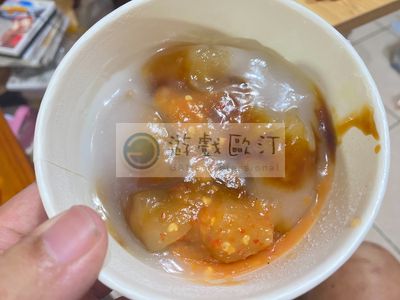傳統的台灣小吃:肉圓
肉圓是一種傳統的台灣小吃,通常被認為是發源於台灣中部地區,尤其以彰化的肉圓最為著名。這道小吃的名字直接翻譯過來就是“肉丸”,但它与其他地方的肉丸有所不同。肉圓的外皮通常由地瓜粉(或太白粉)製成,內餡則以豬肉為主,有時還會加入香菇、竹筍、蝦仁等配料。肉圓的特色在於其Q彈有嚼勁的外皮,配合內餡的鮮美,並佐以特製的甜鹹醬料,使得這道小吃在台灣各地廣受歡迎。
製作肉圓的過程相當繁複,首先是外皮的製作。地瓜粉是製作外皮的主要原料,通常會將地瓜粉與水混合,並且以熱水攪拌,使其形成濃稠的糊狀。接著將這些地瓜粉糊蒸熟或煮熟,待其冷卻後便能成為富有彈性的外皮材料。內餡的製作則相對簡單,豬肉通常會被切成小塊或剁成肉末,然後加入調味料進行拌勻。根據個人或地區口味的不同,內餡中可能還會加入切碎的香菇、竹筍、蝦仁等配料,以增加風味和口感。
接下來是組裝的過程,將一小團外皮材料撕開或壓平,然後包入適量的內餡,再把外皮收攏,將其捏成圓形,形成一個個小圓球狀。傳統的做法是將這些包好的肉圓放入蒸籠中蒸熟,有些地區則是將其放入油鍋中油炸,炸至表皮金黃酥脆。最後是肉圓的調味和上桌,通常會搭配一種特製的甜鹹醬料,這種醬料一般由醬油、蒜泥、糖、醋等混合調製而成,有些地方會加一點辣椒醬以增添風味。肉圓通常會在上桌前淋上醬料,並且撒上一些香菜或蔥花作為點綴。
肉圓作為台灣的經典小吃,已經深深融入台灣的飲食文化中,無論是在夜市、街頭小販,還是傳統市場,都能見到肉圓的身影。它不僅是一道美味的小吃,更是台灣飲食文化的一部分,象徵著台灣人對於食材的運用和傳統口味的堅持。
Ba-wan is a traditional Taiwanese snack, often considered to have originated in the central region of Taiwan, with Changhua being particularly famous for its version. The name "Ba-wan" directly translates to "meatball," but it differs significantly from meatballs found elsewhere. The outer shell of Ba-wan is typically made from sweet potato starch (or tapioca starch), while the filling mainly consists of pork, sometimes accompanied by mushrooms, bamboo shoots, shrimp, and other ingredients. The defining characteristic of Ba-wan is its chewy, elastic outer shell, which complements the savory filling. This combination, along with a special sweet and salty sauce, makes Ba-wan a popular dish across Taiwan.
The process of making Ba-wan is quite elaborate, beginning with the preparation of the outer shell. Sweet potato starch is the primary ingredient, usually mixed with water and stirred with hot water to form a thick paste. This paste is then steamed or boiled until cooked, and once cooled, it becomes a flexible and elastic dough suitable for shaping the outer shell.
The filling is relatively simple to prepare. Pork is typically cut into small pieces or minced, then mixed with seasonings. Depending on personal or regional preferences, the filling may also include chopped mushrooms, bamboo shoots, shrimp, and other ingredients to enhance the flavor and texture.
Next comes the assembly process. A small portion of the dough is torn or flattened, and a suitable amount of filling is placed inside. The dough is then gathered around the filling and shaped into a small ball, creating a round, dumpling-like shape. Traditionally, these assembled Ba-wan are placed in a steamer and cooked until done, though in some regions, they are deep-fried until the outer shell is golden and crispy.
Finally, the Ba-wan is seasoned and served. It is usually accompanied by a special sweet and salty sauce, typically made from a mixture of soy sauce, minced garlic, sugar, and vinegar. Some regions may also add a bit of chili sauce for extra flavor. Before serving, the Ba-wan is drizzled with this sauce and garnished with cilantro or chopped green onions.
As a classic Taiwanese snack, Ba-wan has become deeply integrated into Taiwanese food culture. Whether at night markets, street vendors, or traditional markets, Ba-wan is a common sight. It is not only a delicious snack but also a symbol of Taiwan's culinary heritage, reflecting the local people's skillful use of ingredients and dedication to preserving traditional flavors.

- 1
- 2
- 3
- 4
